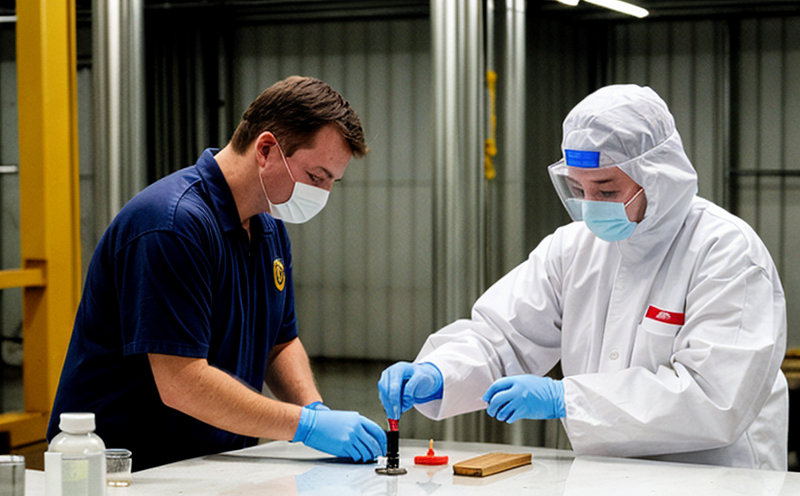ISO 22088-3 Heat and Cold Resistance Test
The ISO 22088-3 standard, part of the broader series on food packaging materials and articles, specifies the procedures for determining the heat and cold resistance properties of these materials. This test is crucial in ensuring that packaging designed to protect food products can withstand temperature variations without compromising its integrity or the safety of the contents.
Understanding the importance of such tests is paramount for quality managers and compliance officers who need to ensure their products meet regulatory standards. For R&D engineers, this test provides insights into material properties under extreme conditions, while procurement teams rely on it to select suppliers capable of delivering materials that can handle temperature fluctuations during storage and distribution.
The process involves subjecting packaging samples to controlled cycles of heat and cold according to specified parameters. The primary goal is to evaluate the physical integrity, chemical stability, and microbial resistance of the packaging after exposure to these conditions. This testing ensures that the packaging remains effective in protecting food from contamination, spoilage, and other quality issues.
Compliance with ISO 22088-3 is mandatory for companies involved in the production or distribution of food packaging materials. It helps ensure product safety, regulatory compliance, and consumer trust by verifying that packaging can maintain its integrity across various environmental conditions. This standard aligns with broader sustainability goals by promoting the use of durable, reliable, and safe packaging solutions.
The testing procedure typically involves placing samples in a controlled environment chamber where temperature cycling is conducted according to predefined schedules. The apparatus used includes precision-controlled chambers capable of simulating real-world storage and transportation conditions. Specimen preparation usually involves cutting samples into standard sizes that can be easily placed within the test chamber.
Upon completion of the testing cycle, the samples are inspected for any changes in physical appearance, structural integrity, chemical composition, or microbial content. Acceptance criteria vary based on the specific requirements outlined in ISO 22088-3. These may include visual inspections, dimensional measurements, chemical analysis, and microbiological evaluations.
The test results provide critical data that can guide improvements in packaging design, material selection, and process optimization. For quality managers, this information helps identify areas where current practices could be enhanced to better meet the demands of modern supply chains and consumer expectations. Compliance officers gain valuable insights into whether their products meet regulatory requirements, ensuring ongoing adherence to standards.
In summary, ISO 22088-3 is an essential tool for safeguarding food packaging integrity under varying thermal conditions. By rigorously testing materials according to this standard, manufacturers can enhance product safety, extend shelf life, and build consumer confidence in their offerings.
Why Choose This Test
- Ensures compliance with international standards
- Guarantees product safety under extreme temperature conditions
- Improves packaging durability and reliability
- Enhances shelf life of packaged products
- Aids in regulatory compliance for food packaging materials
- Provides valuable data for material selection and process optimization
- Safeguards against potential contamination during storage and transportation
- Bolsters consumer trust by demonstrating adherence to stringent quality controls
Quality and Reliability Assurance
The ISO 22088-3 heat and cold resistance test plays a pivotal role in ensuring the reliability and safety of food packaging materials. By subjecting samples to controlled temperature cycles, this test evaluates how well the packaging can withstand thermal stress without compromising its integrity or compromising the quality of the packaged product.
For quality managers, this test offers several key benefits:
- Improved Product Safety: Ensures that packaging remains intact and prevents contamination during extreme temperature fluctuations.
- Durability and Reliability: Identifies potential weaknesses in the material that might lead to premature failure or reduced performance over time.
- Regulatory Compliance: Meets stringent requirements set by international regulatory bodies, thereby avoiding costly recalls and reputational damage.
- Data-Driven Decision Making: Provides actionable insights into the effectiveness of current materials and processes, enabling informed decisions for future improvements.
The test also serves as a critical tool for R&D engineers in refining packaging designs. By simulating real-world conditions, it helps uncover areas where modifications are necessary to enhance performance or durability. For compliance officers, ISO 22088-3 ensures that all products meet the stringent quality and safety standards required by various jurisdictions.
In essence, this test is not just about meeting regulatory requirements; it’s a commitment to excellence in product design and manufacturing, which ultimately leads to higher consumer satisfaction and trust.
Environmental and Sustainability Contributions
The ISO 22088-3 heat and cold resistance test contributes significantly to environmental sustainability by promoting the use of materials that are not only durable but also environmentally friendly. By ensuring that packaging can withstand extreme temperature conditions without degradation, this test supports the development of sustainable packaging solutions.
One key aspect is the reduction in waste associated with damaged or compromised packaging. When packaging fails under thermal stress, it often results in wasted product and increased environmental impact. By identifying materials capable of enduring such stresses, companies can minimize waste and reduce their carbon footprint.
In addition to reducing waste, this test also supports the lifecycle approach to sustainability by ensuring that packaging remains effective throughout its entire life cycle—from production to disposal. This reduces the need for frequent replacements, thus conserving resources and energy.
The test also encourages innovation in material science, leading to the development of eco-friendly alternatives that are both thermally stable and sustainable. By fostering a culture of continuous improvement, ISO 22088-3 helps drive progress towards more environmentally responsible packaging solutions.
In conclusion, while primarily focused on ensuring product safety and quality, this test plays a crucial role in promoting environmental sustainability by encouraging the use of durable, reliable, and sustainable materials. This aligns with broader global efforts to reduce waste and protect natural resources for future generations.





